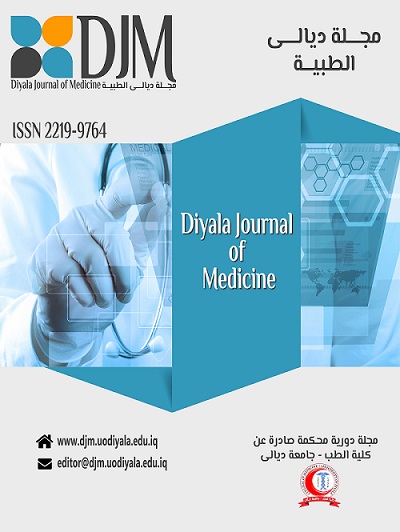Abstract
Background: Pemphigus vegetans is a very rare form of pemphigus vulgaris , with a similar
etiology and early histological changes , it comprise only 1-2% of cases and of two variety
(Neumann and Hallopeau) . It begins and ends as pemphigus vulgaris clinically and
histologically , but many of the denuded areas heal with verrucous vegetations and epidermal
hyperplasia , that may contain small pustules in the early stages .
Objectives: The study was done to identify that pemphigus vegetans may be manifested for
the first time on the body of the nose , as a well defined , indurated , slightly elevated
verrucous , hypertrophic and erythematous plaque .
Patients and methods : Eight patients were seen in the Department of Dermatology and
Venereolgy in Baghdad and Baquba Teaching Hospitals , during the period from Nov. 2001
to Dec. 2004 . All of them were males with a mean age of 45 years (their ages ranged from
30-81years) . They complained of vegetating plaques on the body of the nose , which were
diagnosed clinically and histologically as pemphigus vegetans and treated by topical
clobetasol dipropoint 0.05% ointment twice daily and 40mg /day prednisolone as a single oral
morning dose .
Results: The study shows that pemphigus vegetans may be manifested for the first time on
the body of the nose , as a well defined slightly elevated erythematous , verrucous and
hypertrophic plaques , with typical histological changes of pemphigus vegetans and good
response to topical clobetasol dipropoint as 0.05% ointment and oral prednisolone 40mg /day
as a single dose .
etiology and early histological changes , it comprise only 1-2% of cases and of two variety
(Neumann and Hallopeau) . It begins and ends as pemphigus vulgaris clinically and
histologically , but many of the denuded areas heal with verrucous vegetations and epidermal
hyperplasia , that may contain small pustules in the early stages .
Objectives: The study was done to identify that pemphigus vegetans may be manifested for
the first time on the body of the nose , as a well defined , indurated , slightly elevated
verrucous , hypertrophic and erythematous plaque .
Patients and methods : Eight patients were seen in the Department of Dermatology and
Venereolgy in Baghdad and Baquba Teaching Hospitals , during the period from Nov. 2001
to Dec. 2004 . All of them were males with a mean age of 45 years (their ages ranged from
30-81years) . They complained of vegetating plaques on the body of the nose , which were
diagnosed clinically and histologically as pemphigus vegetans and treated by topical
clobetasol dipropoint 0.05% ointment twice daily and 40mg /day prednisolone as a single oral
morning dose .
Results: The study shows that pemphigus vegetans may be manifested for the first time on
the body of the nose , as a well defined slightly elevated erythematous , verrucous and
hypertrophic plaques , with typical histological changes of pemphigus vegetans and good
response to topical clobetasol dipropoint as 0.05% ointment and oral prednisolone 40mg /day
as a single dose .
Keywords
Pemphigus vulgaris
pemphigus vegetans
clo
Abstract
الخلفية: الفقاع النباتي هو شكل نادر جدًا من الفقاع الشائع، وله مسببات مرضية مماثلة وتغيرات نسيجية مبكرة، ويشكل 1-2% فقط من الحالات وينتمي إلى نوعين
(نيومان وهالوبو). يبدأ وينتهي بالفقاع الشائع سريريًا ونسيجيًا، ولكن العديد من المناطق العارية تلتئم بنباتات ثؤلولية وفرط تنسج البشرة، والذي قد يحتوي على بثور صغيرة في المراحل المبكرة.
الأهداف: أجريت الدراسة لتحديد ما إذا كان الفقاع النباتي قد يظهر لأول مرة على جسم الأنف، على شكل لويحة ثؤلولية متضخمة ومحمرة ومحددة جيدًا ومرتفعة قليلاً.
المرضى والطرق: تم فحص ثمانية مرضى في قسم الأمراض الجلدية والتناسلية في مستشفيات بغداد وبعقوبة التعليمية خلال الفترة من تشرين الثاني 2001 إلى كانون الأول 2004. وكان جميعهم من الذكور بمتوسط عمر 45 سنة (تراوحت أعمارهم بين 30-81 سنة). وقد اشتكوا من ظهور لويحات نباتية على جسم الأنف، والتي تم تشخيصها سريرياً ونسيجياً على أنها فقاع نباتي وتم علاجها بمرهم كلوبيتاسول ديبروبونت 0.05% الموضعي مرتين يومياً و40 ملغ/يوم بريدنيزولون كجرعة صباحية واحدة عن طريق الفم.
النتائج: أظهرت الدراسة أن الفقاع النباتي قد يظهر لأول مرة على جسم الأنف، على شكل لويحات حمراء وثؤلولية ومتضخمة ومحددة المعالم، مع تغيرات نسيجية نموذجية للفقاع النباتي واستجابة جيدة لكلوبيتاسول ديبروبوينت الموضعي في شكل مرهم 0.05٪ وبريدنيزولون عن طريق الفم 40 مجم / يوم
كجرعة واحدة.
(نيومان وهالوبو). يبدأ وينتهي بالفقاع الشائع سريريًا ونسيجيًا، ولكن العديد من المناطق العارية تلتئم بنباتات ثؤلولية وفرط تنسج البشرة، والذي قد يحتوي على بثور صغيرة في المراحل المبكرة.
الأهداف: أجريت الدراسة لتحديد ما إذا كان الفقاع النباتي قد يظهر لأول مرة على جسم الأنف، على شكل لويحة ثؤلولية متضخمة ومحمرة ومحددة جيدًا ومرتفعة قليلاً.
المرضى والطرق: تم فحص ثمانية مرضى في قسم الأمراض الجلدية والتناسلية في مستشفيات بغداد وبعقوبة التعليمية خلال الفترة من تشرين الثاني 2001 إلى كانون الأول 2004. وكان جميعهم من الذكور بمتوسط عمر 45 سنة (تراوحت أعمارهم بين 30-81 سنة). وقد اشتكوا من ظهور لويحات نباتية على جسم الأنف، والتي تم تشخيصها سريرياً ونسيجياً على أنها فقاع نباتي وتم علاجها بمرهم كلوبيتاسول ديبروبونت 0.05% الموضعي مرتين يومياً و40 ملغ/يوم بريدنيزولون كجرعة صباحية واحدة عن طريق الفم.
النتائج: أظهرت الدراسة أن الفقاع النباتي قد يظهر لأول مرة على جسم الأنف، على شكل لويحات حمراء وثؤلولية ومتضخمة ومحددة المعالم، مع تغيرات نسيجية نموذجية للفقاع النباتي واستجابة جيدة لكلوبيتاسول ديبروبوينت الموضعي في شكل مرهم 0.05٪ وبريدنيزولون عن طريق الفم 40 مجم / يوم
كجرعة واحدة.
Keywords
الفقاع الشائع، الفقاع النباتي، كلوبيتاسول ديب
